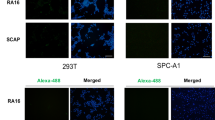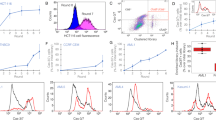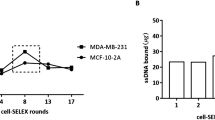Abstract
In an effort to target the in vivo context of tumor-specific moieties, we screened a large library of nuclease-resistant RNA oligonucleotides in tumor-bearing mice to identify candidate molecules with the ability to localize to hepatic colon cancer metastases. One of the selected molecules is an RNA aptamer that binds to p68, an RNA helicase that has been shown to be upregulated in colorectal cancer.
This is a preview of subscription content, access via your institution
Access options
Subscribe to this journal
Receive 12 print issues and online access
$259.00 per year
only $21.58 per issue
Buy this article
- Purchase on Springer Link
- Instant access to full article PDF
Prices may be subject to local taxes which are calculated during checkout



Similar content being viewed by others
References
Tuerk, C. & Gold, L. Science 249, 505–510 (1990).
Famulok, M., Hartig, J.S. & Mayer, G. Chem. Rev. 107, 3715–3743 (2007).
Ellington, A.D. & Szostak, J.W. Nature 346, 818–822 (1990).
Sullenger, B.A. & Cech, T.R. Science 262, 1566–1569 (1993).
Abdelhaleem, M. Clin. Biochem. 38, 499–503 (2005).
Causevic, M. et al. Oncogene 20, 7734–7743 (2001).
Shin, S., Rossow, K.L., Grande, J.P. & Janknecht, R. Cancer Res. 67, 7572–7578 (2007).
Yang, L., Lin, C. & Liu, Z.R. Mol. Cancer Res. 3, 355–363 (2005).
Iggo, R.D. & Lane, D.P. EMBO J. 8, 1827–1831 (1989).
Lamm, G.M., Nicol, S.M., Fuller-Pace, F.V. & Lamond, A.I. Nucleic Acids Res. 24, 3739–3747 (1996).
Rossow, K.L. & Janknecht, R. Oncogene 22, 151–156 (2003).
Srivastava, M. & Pollard, H.B. FASEB J. 13, 1911–1922 (1999).
Soundararajan, S., Chen, W., Spicer, E.K., Courtenay-Luck, N. & Fernandes, D.J. Cancer Res. 68, 2358–2365 (2008).
Essler, M. & Ruoslahti, E. Proc. Natl. Acad. Sci. USA 99, 2252–2257 (2002).
Raddatz, M.S. et al. Angew. Chem. Int. Edn Engl. 47, 5190–5193 (2008).
Berezovski, M.V., Lechmann, M., Musheev, M.U., Mak, T.W. & Krylov, S.N. J. Am. Chem. Soc. 130, 9137–9143 (2008).
Hicke, B.J. et al. J. Biol. Chem. 276, 48644–48654 (2001).
Shi, H., Fan, X., Sevilimedu, A. & Lis, J.T. Proc. Natl. Acad. Sci. USA 104, 3742–3746 (2007).
Acknowledgements
We thank Z.R. Liu for kindly providing the p68-expressing plasmid pHM6 (Georgia State University) and Y. Wang for his insightful suggestions. We thank Y. Zhao, Z. Vujaskovic, H. Guo, Z. Mi and D. Wang for their technical assistance. We also are grateful to C. Kontos and X. Zhang for their critical reading of this manuscript. This work was supported by the Elsa U. Pardee Foundation (J.M.), an American Cancer Society pilot award (J.M.) and US National Institutes of Health grants NIH-5U19-AI-067798-04 (Z.N.R.) and NIH-R01-CA129190 (B.A.S.).
Author information
Authors and Affiliations
Contributions
J.M. designed and performed the research investigations described and wrote the manuscript. Y.L. and J.H.U. contributed to the in vitro binding and gel-shift assays. Z.N.R. performed the fluorescent and immunohistochemical work in mice and cells. Z.Y. provided useful reagents, assisted in imaging of cells and tissues, and analyzed the data. B.A.S. provided supervision, including the conduct of and interpretation of the investigations, and edited the manuscript. B.M.C. generated the conceptual basis for performing in vivo selection as a means of interrogating the in vivo environment, provided supervision, including the conduct of and interpretation of the investigations, and edited the manuscript.
Corresponding authors
Supplementary information
Supplementary Text and Figures
Supplementary Figures 1–3, Supplementary Table 1 and Supplementary Methods (PDF 317 kb)
Rights and permissions
About this article
Cite this article
Mi, J., Liu, Y., Rabbani, Z. et al. In vivo selection of tumor-targeting RNA motifs. Nat Chem Biol 6, 22–24 (2010). https://doi.org/10.1038/nchembio.277
Received:
Accepted:
Published:
Issue Date:
DOI: https://doi.org/10.1038/nchembio.277
This article is cited by
-
In vitro selection of aptamers and their applications
Nature Reviews Methods Primers (2023)
-
Advances in aptamer-based nuclear imaging
European Journal of Nuclear Medicine and Molecular Imaging (2022)
-
2D graphene oxide–aptamer conjugate materials for cancer diagnosis
npj 2D Materials and Applications (2021)



